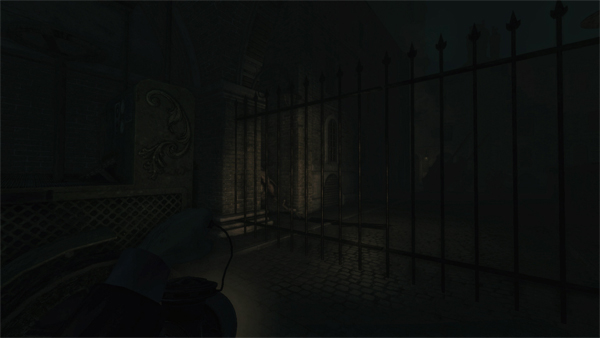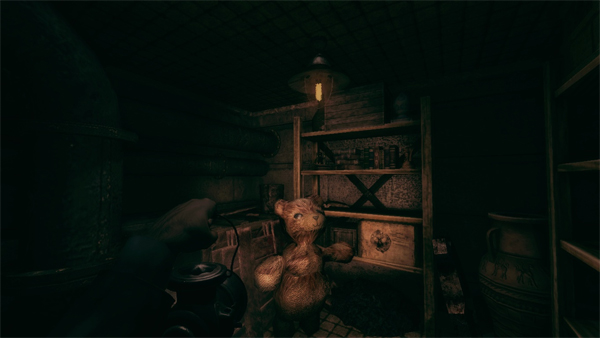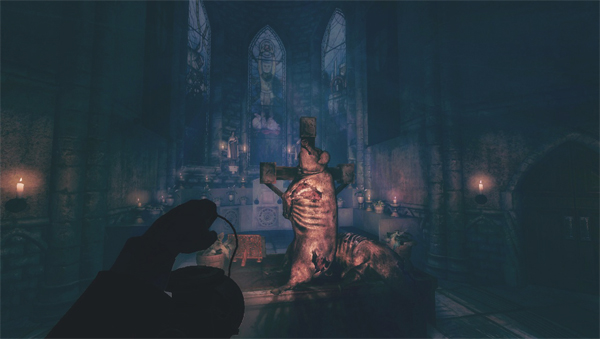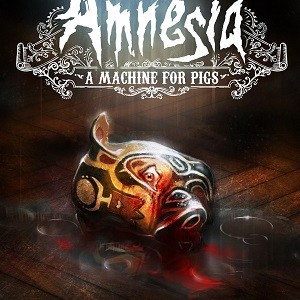In 2010, Frictional Games’ Amnesia: The Dark Descent breathed new life into a faltering horror genre that was becoming increasingly obsessed with the glitz and glamour of action shooters and their mass-market appeal. This first-person horror adventure completely disempowered players and overwhelmed them with unrelenting sensations of danger and helplessness in a foreign environment. The experience was steeped in the unknown and full of nightmarish monsters that fed the fires of fear like an urban legend.

Amnesia: A Machine for Pigs, an outsourced semi-sequel helmed by Dear Esther developer The Chinese Room, fails to match the horror precedent set by The Dark Descent, instead streamlining play and narrative, and removing the elements that slowly and tortuously built fear in the game’s predecessor. The core of this game is a story of madness, attended obediently by the player from beginning to end, with little room to wander, and little room to actually feel. What should be strange and disturbing machinations of a man possessed, a dark exploration of psychosis and depravity, feels lukewarm in its delivery. Much like Dear Esther, the player is simply an audience to which this tale is told, rather than a participant in the world that is presented; protagonist Mandus is observed rather than embodied, and the story is watched rather than lived.
The ineffectiveness of A Machine for Pigs’ narrative is largely a function of the game’s mechanics. Having been stripped of the very elements that made The Dark Descent a shining example of ludonarrative consonance, this sequel feels quite the opposite.
To tell the story at intervals, via phone calls, scattered documents, and Mandus’s own journal entries, would be effective if the world also supported those authored clippings in a more organic, emergent way. In A Machine for Pigs, however, the environment tells the audience little beyond what is explicitly stated in those dialogues. There is little to learn about this world by delving deeper; shrouded, nonessential content that could serve to intensify one’s connection to the fiction simply doesn’t exist. The mystery of the narrative is stingily rationed, and suffers for it. The term “Lovecraftian” does not apply here.
 Despite the game operating on a physics engine in which the primary method of control is to manipulate objects via a hand icon in the center of the screen, interaction with the world is limited to only a few key options. Opening and closing doors, drawers, gates, and windows are supplemented by throwing switches and carrying items, but these actions are only occasionally combined into feats of consequence or interest. The game presents only a few simple puzzles to be solved, and this lack of cognitive engagement prevents player and avatar coalescence. How can one be fearful while disengaged?
Despite the game operating on a physics engine in which the primary method of control is to manipulate objects via a hand icon in the center of the screen, interaction with the world is limited to only a few key options. Opening and closing doors, drawers, gates, and windows are supplemented by throwing switches and carrying items, but these actions are only occasionally combined into feats of consequence or interest. The game presents only a few simple puzzles to be solved, and this lack of cognitive engagement prevents player and avatar coalescence. How can one be fearful while disengaged?
Mankind’s natural fear of the unknown is exemplified in darkness, and granting players a lantern that never runs dry provides no reason to ever shy away from the security of the light. Stepping out of one’s comfort zone into that scary unknown puts one on edge and ensures that the goosebumps never go away. Worrying about conserving the power of light, choosing when to deliberately suffer that discomfort in order to avoid the consequences of depleting the valuable and protective resource, is like drip-feeding adrenaline through the body, maintaining the heightened sensation of a fight-or-flight response across hours of slow, uncertain exploration. A Machine for Pigs does nothing like this. A Machine for Pigs offers unlimited comfort with its lantern. Comfort is not horror.
 Possibly the greatest mistake the game makes, however, is inextricably bound to every shred of the experience. The unfortunate fact is that the game is not scary, in great part due to its purely laughable antagonists and the way they are introduced. Unlike The Dark Descent, the majority of which only alluded to the unspeakable and menacing horrors that the player would barely ever see (because just looking at them for too long made protagonist Daniel go mad and die), the monsters in A Machine for Pigs are well understood before ever taking the first step into the darkness. It is abundantly clear from the first silly pig mask and the first pile of pig corpses that pig-man-monsters will inevitably make their not-so-grand appearance in an effort to spook the player. Suspense is further deflated each time a pig-man is put safely on display, allowing the player to gawk at and become familiar with these easily avoidable, more-mechanical-than-menacing jokes.
Possibly the greatest mistake the game makes, however, is inextricably bound to every shred of the experience. The unfortunate fact is that the game is not scary, in great part due to its purely laughable antagonists and the way they are introduced. Unlike The Dark Descent, the majority of which only alluded to the unspeakable and menacing horrors that the player would barely ever see (because just looking at them for too long made protagonist Daniel go mad and die), the monsters in A Machine for Pigs are well understood before ever taking the first step into the darkness. It is abundantly clear from the first silly pig mask and the first pile of pig corpses that pig-man-monsters will inevitably make their not-so-grand appearance in an effort to spook the player. Suspense is further deflated each time a pig-man is put safely on display, allowing the player to gawk at and become familiar with these easily avoidable, more-mechanical-than-menacing jokes.
For a tour into an unusual and gruesome game world, Amnesia: A Machine for Pigs serves its purpose. The story of how Mandus aims to save his children from the core of an underground hell-factory is at least compelling enough to keep a player interested in continuing all the way to the game’s anti-climax. But as a work of horror, A Machine for Pigs never reaches into the emotional core of its audience to pull that vital fear response to the forefront of the experience where it should be.


















